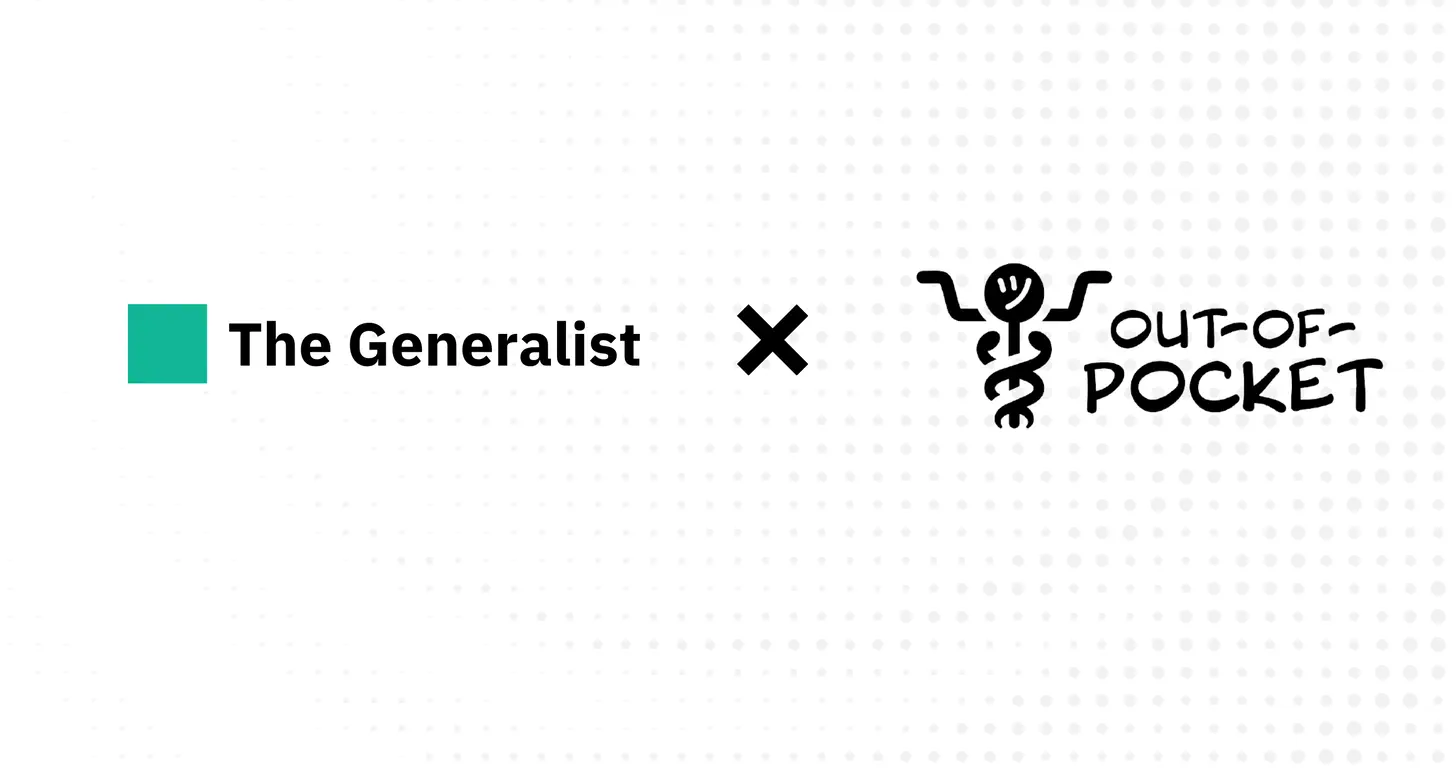Six Healthcare Startup Ideas
Get Out-Of-Pocket in your email
Looking to hire the best talent in healthcare? Check out the OOP Talent Collective - where vetted candidates are looking for their next gig. Learn more here or check it out yourself.
 Hire from the Out-Of-Pocket talent collective
Hire from the Out-Of-Pocket talent collectiveNetwork Effects: Interoperability 101
.gif)
Featured Jobs
Finance Associate - Spark Advisors
- Spark Advisors helps seniors enroll in Medicare and understand their benefits by monitoring coverage, figuring out the right benefits, and deal with insurance issues. They're hiring a finance associate.
- firsthand is building technology and services to dramatically change the lives of those with serious mental illness who have fallen through the gaps in the safety net. They are hiring a data engineer to build first of its kind infrastructure to empower their peer-led care team.
- J2 Health brings together best in class data and purpose built software to enable healthcare organizations to optimize provider network performance. They're hiring a data scientist.
Looking for a job in health tech? Check out the other awesome healthcare jobs on the job board + give your preferences to get alerted to new postings.
This week I did a collaboration with The Generalist. The Generalist is one of the few newsletters I read end-to-end every time because it’s important to learn how things work in normal businesses to understand which lessons/strategies can be imported to healthcare.

We gathered a bunch of startup ideas from folks across the healthcare industry. I liked this because I am lazy and this didn’t require me to write anything. But also because the ideas people came up with were really good. Let me know what you think of them.
Real-Time API for Doctor Capacity
ITA for healthcare
Google acquired ITA Software, a company that tracked airline inventories, that would eventually underpin Google Flights. This software let any airline connect their inventory and enabled booking and dynamic pricing through the platform.
Healthcare needs something similar for surfacing real-time provider capacity at a national scale to facilitate efficient appointment booking. Scheduling in healthcare is still a mess. Each provider uses multiple scheduling systems, and no one has a comprehensive view into the overall appointment capacity of a given provider network. We also have an explosion of virtual care and home health companies that require another level of complex resource management and logistics coordination that needs to interface effectively with traditional providers. Creating a universal scheduling infrastructure would enable third-parties/startups to surface live availability in their apps and allow referring providers and consumers alike to utilize capacity more efficiently.
— Julie Yoo, General Partner at Andreessen Horowitz
QVC for digital health
Live-streaming demo sales for DTC medical products
COVID proved two things. One, patients are willing to adopt digital health technology, and two, despite this openness, they remain out of the loop and unaware of which products would best meet their needs.
I think there’s an opportunity to create a QVC-like live-streaming channel that features different healthcare products. The Sales Development Representatives (SDRs) of various startups could come onto the channel and explain their solution’s value. Patient reviews would be integrated, ensuring recommendations did not go unchecked, and the best products rose to the top.
All in all, a solution like this would make discovery more direct and interactive. It could prove especially popular among older generations accustomed to this kind of DTC sales approach.
— Mario Amaro, MD, CEO at DocSpace
Culture-first treatment
Value-based care targeted by ethnicity
Value-based care (VBC) is a healthcare model in which service providers are reimbursed based on the outcomes they achieve. It’s intended to better align the incentives between a healthcare provider like a hospital or clinic and the patient.
I think there’s room to innovate on this model by narrowing the focus area. In particular, I’d like to see a network of VBC primary care providers (PCPs) that focus on specific immigrant communities, bolstering its service accordingly. For example, this network could serve the Indian-American communities in Dublin, OH, the Persian-Americans in Los Angeles, CA, or the Arab-Americans in Dearborn, MI, Somalian-Americans in St Paul, MN, etc. Each center would incorporate relevant religious and cultural practices, impacting the food, ambiance, and presentation of care. Instead of being “culturally sensitive,” this network would be genuinely “culture-first.” The model would simultaneously cater to the caregivers -- the first generation children who will feel comfortable promoting and supporting having their parents be a part of this new community.
— Misha Nasrollahzadeh, Strategic Partnerships Lead at Ribbon Health
Therapy-led primary care
A therapist to quarterback your day-to-day health needs
Behavioral health (BH) still sits outside core primary care. Though access to BH services is increasing, and more primary care startups like OneMed and Tia are offering therapy alongside their primary care services, BH is fundamentally an "add on" service, often accessible only via referral. This feels very contrary to the massive amount of evidence for the mind-body connection and the increasing BH load in the US.
I believe there's an opportunity to re-think how behavioral health is integrated into primary care, where a therapist would be the intake point and "quarterback,” with PCPs and specialists reserved for truly clinical work. There would be several benefits, a major one being the ability to induce, track, and improve behavior change around health, which health-tech has struggled with. There would be more opportunities for "lower licensed" professionals to offer care (like social workers and coaches) and ideally decreased reliance on medication and procedures to address common health aberrations.
This is a big idea in the niche functional medicine and integrative therapy spaces, primarily for people with chronic conditions. But with telehealth and parity laws increasing, there could be a huge opportunity to build a system that expands access to this approach.
CROs of the future
Distributed, therapeutically-specialized clinical research organizations (CROs)
It’s no secret that pre-FDA approval biotech startups are little more than lightweight business and fundraising shells around a (typically outsourced) clinical trial machine. These clinical trial machines, known as Clinical Research Organizations (CROs)‚ are responsible for the vast majority of a biotech startup’s costs and have substantial fixed costs in physical site locations, medical and scientific staff, and payouts to patients. So it stands to reason that any intervention in reducing the cost of clinical trials has to start with the CRO.
As with any business, there are two levers to improving the CRO:
- Reduction of costs (table-stakes; where most CRO startups focus)
- Increasing value-add
A “CRO of the future” could innovate on both points.
Concerning cost-reduction, CROs should innovate on the model of distribution. Specifically, they can start to bring trials to patients, eliminate fixed site costs, and build economies of scale by focusing on a particular underserved therapeutic area (e.g., rare diseases; women’s health).
In terms of increasing value, it’s essential to understand that many biotech companies have only one or two shots on goal. They raise capital to try to bring a single compound to market, and if that compound fails in its particular formulation, the business dies. Recognizing this, a modern CRO should support startup partners by identifying other viable indication areas (e.g., dermatology) and formulations, helping them build a case to raise capital for additional, parallel trials. In addition to increasing the revenue of the CRO, this increases the likelihood that any single biotech startup will get the treatment approved, thereby reducing the time it takes for a treatment to get into the hands of patients."
Bonus: CAPTCHA for Health Images
Help tag and annotate de-identified images
One of the big barriers to training ML models is having structured, annotated image datasets. CAPTCHA has been deployed across the internet for security purposes and training datasets for things like autonomous cars. Having a medical-specific CAPTCHA for things like MRIs, CT Scans, Tissue Slides, and so on where physicians tag anomalies or guess the diagnosis could create a valuable, massively labeled dataset. This would need to be on platforms only physicians could access or rely on a verification system to ensure the person tagging is a physician.
This behavior could be incentivized through perks, like discount access to relevant journals.
— Nikhil Krishnan, Founder at Out-Of-Pocket, 2x World Record Holder for most thoughts thunk
Thinkboi out,
Nikhil aka. “more of an ideas guy”
Twitter: @nikillinit
INTERLUDE - FEW COURSES STARTING VERY SOON!!
See All Courses →A reminder that there’s a few courses STARTING VERY SOON!!
LLMs in healthcare (starts 9/8) - We break down the basics of Large Language Models like chatGPT, talk about what they can and can’t do in healthcare, and go through some real-world examples + prototyping exercises.
Healthcare 101 (starts 9/22) - I’ll teach you and your team how healthcare works. How everyone makes money, the big laws to know, trends affecting payers/pharma/etc.

We’ll do group rates, custom workshops, etc. - email sales@outofpocket.health and we’ll send you details.
INTERLUDE - FEW COURSES STARTING VERY SOON!!
See All Courses →A reminder that there’s a few courses STARTING VERY SOON!! And it’s the final run for all of them (except healthcare 101).
LLMs in healthcare (starts 9/8) - We break down the basics of Large Language Models like chatGPT, talk about what they can and can’t do in healthcare, and go through some real-world examples + prototyping exercises.
Healthcare 101 (starts 9/22) - I’ll teach you and your team how healthcare works. How everyone makes money, the big laws to know, trends affecting payers/pharma/etc.
How to contract with Payers (starts 9/22) - We’ll teach you how to get in-network with payers, how to negotiate your rates, figure out your market, etc.
We’ll do group rates, custom workshops, etc. - email sales@outofpocket.health and we’ll send you details.
INTERLUDE - FEW COURSES STARTING VERY SOON!!
See All Courses →A reminder that there’s a few courses STARTING VERY SOON!! And it’s the final run for all of them (except healthcare 101).
LLMs in healthcare (starts 9/8) - We break down the basics of Large Language Models like chatGPT, talk about what they can and can’t do in healthcare, and go through some real-world examples + prototyping exercises.
Healthcare 101 (starts 9/22) - I’ll teach you and your team how healthcare works. How everyone makes money, the big laws to know, trends affecting payers/pharma/etc.
How to contract with Payers (starts 9/22) - We’ll teach you how to get in-network with payers, how to negotiate your rates, figure out your market, etc.
Selling to Health Systems (starts 10/6) - Hopefully this post explained the perils of selling point solutions to hospitals. We’ll teach you how to sell to hospitals the right way.
EHR Data 101 (starts 10/14) - Hands on, practical introduction to working with data from electronic health record (EHR) systems, analyzing it, speaking caringly to it, etc.
We’ll do group rates, custom workshops, etc. - email sales@outofpocket.health and we’ll send you details.
INTERLUDE - FEW COURSES STARTING VERY SOON!!
See All Courses →Our Healthcare 101 Learning Summit is in NY 1/29 - 1/30. If you or your team needs to get up to speed on healthcare quickly, you should come to this. We'll teach you everything you need to know about the different players in healthcare, how they make money, rules they need to abide by, etc.
Sign up closes on 1/21!!!
We’ll do group rates, custom workshops, etc. - email sales@outofpocket.health and we’ll send you details.

Interlude - Our 3 Events + LLMs in healthcare
See All Courses →We have 3 events this fall.
Data Camp sponsorships are already sold out! We have room for a handful of sponsors for our B2B Hackathon & for our OPS Conference both of which already have a full house of attendees.
If you want to connect with a packed, engaged healthcare audience, email sales@outofpocket.health for more details.







